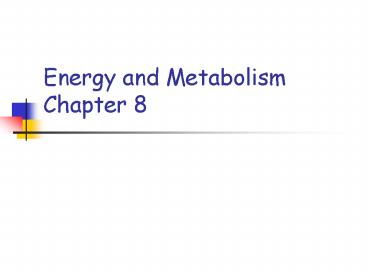Energy and Metabolism Chapter 8 - PowerPoint PPT Presentation
Title:
Energy and Metabolism Chapter 8
Description:
Energy and Metabolism Chapter 8 – PowerPoint PPT presentation
Number of Views:394
Avg rating:3.0/5.0
Title: Energy and Metabolism Chapter 8
1
Energy and MetabolismChapter 8
2
Energy
3
Energy
4
Energy
5
Metabolism
- All chemical reactions carried out by the cell
6
Metabolism
- Catabolic reactions
- Break down large molecules into smaller
substances - Releases energy or is exergonic
7
Metabolism
- Anabolic reactions
- Synthesis of large molecules from smaller
substances - Requires energy or is endergonic
8
Metabolism
- Biochemical pathways
- Reactions in a cell that occur in sequence
- Product of one reaction becomes substrate in
next reaction - Pathways are highly regulated coordinated
- Feedback inhibition
- End product of a reaction inhibits the pathway
from producing more.
9
Energy
10
Energy
- Bioenergetics
- Analysis of how energy powers activities of
living systems - Growth, order, reproduction, responsiveness
regulation - Require energy to happen
11
Energy
- Energy
- Capacity to do work
- Kinetic energy
- Energy of motion
- Potential energy
- Energy of position or stored energy
12
Energy
- Kinetic energy
- Potential energy
13
Energy
- Most of the work done by living organisms is the
transformation of potential energy to kinetic
energy - Thermodynamics
- Study of energy heat changes
14
Energy
- Sun main source of energy
- Energy from sun is used to combine smaller
molecules to make larger molecules - Energy is then stored in the chemical bond
15
Energy
- Redox(oxidation-reduction) reactions
- Transfer of an electron or electrons
- Play a key role in flow of energy in biological
systems - An electron is passed from one atom to another
energy is passed
16
Law of thermodynamics
- Laws of thermodynamics govern all energy changes
in the universe. - First law of thermodynamics
- Energy cannot be created or destroyed
- It can change from one form to another.
(potential to kinetic) - Total amount of energy stays the same
17
First law
- In living organisms
- Eating transfers energy from bonds in food to
organism - Potential energy is transferred to kinetic energy
18
First Law
- Heat random motion of molecules
- Heat can be lost during conversions
- Sun replaces energy that is lost as heat
19
Second law
- Second law of thermodynamics
- Transformation of PE to heat (random motion of
molecules). - Entropy (disorder) in universe is increasing
20
Second law
- Energy transformations tend to proceed
spontaneously - Convert matter from a more ordered state to a
less ordered - More stable state.
21
Second law
- Entropy(s) Disorder in a system
- Enthalpy (H) heat content
- Free energy(G) Amount of energy available to do
work in any system. - Amount of energy available to break then make
other chemical bonds
22
Second law
- GGibbs free energy
- ?G ??H - T?S (TKelvin temp)
- ?G is positive than products have more energy
than reactants - Due to more energy in bonds or less randomness
- Endergonic reaction
23
Endergonic reaction
24
Second law
- ?G is negative products have less energy than
reactants - H is lower (bond energy) or
- S is greater- more randomness
- Exergonic any reaction that releases energy
25
Exergonic reaction
26
Exergonic reactions
27
Energy
28
ATP
- ATP powers energy requiring processes in cell
- 1. Chemical work (making polymers)
- 2. Transporting substances across the membranes
- 3. Mechanical work
- Muscle movement, cilia
29
ATP
- Structure of ATP
- Ribose sugar
- Adenine
- 3 phosphate attached in a row
30
ATP
31
ATP
32
ATP
- ATP
- ADP
- Losses a inorganic phosphate
- Hydrolysis
- 7.3kcal/mole of energy is released.
33
Activation Energy
- Energy needed to initiate a reaction
- Exergonic endergonic reactions both require
activation energy. - Reactions with higher AE tend to move forward
more slowly
34
(No Transcript)
35
Enzymes
- Catalyst in living organisms
- Large three-dimensional globular protein
36
Enzymes
- Substrate Molecule that is going to undergo the
reaction - Active sites Specific spots on enzyme that
substrates bind to. - Enzyme-substrate complex enzymes are bound to
substrates with a precise fit. - Induced fit when the substrate causes the enzyme
to adjust to make a better fit - ES ES E P
37
(No Transcript)
38
Enzymes
- Only small amounts are necessary
- Can be recycled
- Specific
- Speeds up reactions
- Different types of cells have different enzymes
- Determine course of chemical reactions in the cell
39
Enzyme examples
- Lipase, protease
- Carbonic anhydrase
- CO2 H2O H2CO3
- Lactate dehydrogenase
- Lactate to pyruvate
- Pyruvate dehydrogenase
- Enzyme that starts the Kreb cycle
40
Enzymes
- Most enzymes are proteins
- RNA has been shown to catalyze some reactions
- Ribozymes
- RNA catalysts are specific speed up reactions
41
Enzymes
- Factors that affect rate of enzyme-catalyzed
reactions - 1. Concentration of the enzyme substrate
- 2. Factors that affect the 3-D shape of the
enzyme - Temperature, pH, salt concentration regulatory
molecules
42
Enzymes
- Inhibitor
- Binds enzyme prevents it from working
- Occurs at end of a pathway to stop reactions
- Two types of inhibitors
- Competitive
- Noncompetitive
43
Enzymes
- Allosteric site
- On/off switch for enzyme
- Allosteric site usually at a different location
than active site - Allosteric inhibitor
- Binds at allosteric site stops enzyme activity
- Activitors
- Bind increases activity
44
(No Transcript)
45
Enzymes
- Cofactor
- Assists enzyme function (Zn, Mg, Cu)
- Coenzymes
- Cofactors that are not proteins but are organic
molecules - Help transfer electrons energy associated with
electrons - Vitamins are coenzymes
- NAD is an important coenzyme































